Wednesday, September 2nd 2020

Intel 11th Gen Core "Tiger Lake" & Xe Graphics Launch Event: Live Blog
Intel today launches its 11th Gen Core "Tiger Lake" mobile processors that introduce several new technologies on the backs of new IP. As described in the Architecture Day, "Tiger Lake" is built on the 10 nm SuperFin process, and combines new "Willow Cove" CPU cores with the first commercial debut of the Xe Gen12 graphics architecture that Intel is betting big on, to make a stab at the consumer graphics and scalar compute markets. Join us in this live-blog.Update 16:00 UTC: GB (Gregory Bryant, EVP Client), leads the event from the comfort of his home.Update 16:04 UTC: Here it is, the "world's best processor for thin and light laptops. You'll notice that like most Intel U-segment chips, this is an MCM of the processor and PCH die. Intel bases its "world's best" claims on a per-segment basis.Update 16:05 UTC: Acer, Dell, HP, Lenovo, and Samsung have devices with 11th Gen Core processor. Devices as light as 870 g, or lighter than the original Apple iPad. 50+ designs are expected for Holiday 2020, 150 will be available eventually.Update 16:07 UTC: Intel's new corporate identity takes flight with the new logos.Update 16:08 UTC: 10 nm SuperFin: 60 poly pitch transistor, improved gate process, higher mobility, lower drain resistance. We detailed this process node here.
Update 16:08 UTC: Super MIM capacitor is the second key component of 10 nm SuperFin. 20% iso power improvements.Update 16:10 UTC: 20% CPU IPC uplift, 2x iGPU performance uplift, 5x AI performance uplift, I/O improvements from Thunderbolt 4 and PCIe gen 4. Find out more about the Willow Cove core and CPU performance uplift in our technical article here.Update 16:11 UTC: LP/DDR5 memory support for future memory. "A processor evolved"
Update 16:12 UTC: Tiger Lake compact logic board for 2-in-1 tablets.Update 16:13 UTC: AI-accelerated performance much higher than AMD 4800U, as is CPU-heavy workloads. Much of Intel's design focus with this generation has been to leverage new AI-acceleration ISA, and suggest practical client-segment applications of the technology, such as in the area of video conferencing, where AI can be used to clear up your audio or blur/replace your background.Update 16:15 UTC: Intel claims iGPU gaming performance lead over AMD's 4800U, including FPS. The Iris Xe represents a generational leap in performance for Intel, and we've been tracking performance benchmarks of this solution for several months now, where it's been trading blows with AMD's Vega-based iGPUs.Update 16:18 UTC: Intel DLBoost will be heavily leveraged for AI-accelerated video-conferencing enhancements and background noise removal.Update 16:18 UTC: Project Athena I/O. With this generation, USB4, Thunderbolt 4 (80 Gbps), and type-C ports take center-stage. Type-A USB will get increasingly rare. This means a whole ecosystem of new USB connectors, adapters, storage devices, and more, on the anvil.Update 16:20 UTC: 1-second availability, like an iPad, fast charging, with 40% charge in 30 minutes. A fast-charging standard for laptops was much needed. Modern batteries charge at much higher voltages.Update 16:22 UTC: New corporate identity.Update 16:29 UTC: Intel EVO powered by Core. It's when 11th Gen Core meets Project Athena. The last time we had such a processor+platform umbrella brand, was with Intel Centrino, from the early 2000s.Update 16:31 UTC: And that's a wrap for this session. In the next one, we'll cover the underlying architecture.We will flesh out this whole post with more details over the next half hour, content will update automatically
Update 17:34 UTC: Intel gets into a technical deep-dive of "Tiger Lake"Update 17:38 UTC: Intel posts some of its first performance guidance for Tiger Lake vs. 4800U.Update 17:41 UTC: Earlier Gregory Bryant, and now Chris Walker, two top Intel execs refer to AMD as "our imitators" rather than "the competition." Clearly Ryzen APUs has Intel rattled, especially with AMD preparing two new APU silicons in 2021.
Update 17:44 UTC: Intel EVO is a combination of Intel Core + Project Athena. Kinda like Intel Centrino, from the 2000s.Update 17:46 UTC: Intel highlights its software Software Enabling Engine ecosystem.Update 17:48 UTC: Intel is betting bigger on AI, going beyond just DLBoost instruction sets.Update 17:51 UTC: Intel develops new DLBoost DP4a evolved instruction set and new GNA accelerator engine.Update 17:56 UTC: An overview of how Tiger Lake is an online collaboration solution powerhouse.Update 17:58 UTC: Here it is! The first die-shot of TGL 4-core die, complete with its new I/O, interfaces. We get to see how much real-estate is taken up by the CPU cores in comparison to the Gen12 Xe iGPU.Update 17:59 UTC: And here's the die-shot of the PCH die. On TGL-U, the PCH die sits on the same package, and talks over in-package DMI.Update 18:00 UTC: Intel details its 10 nm SuperFin foundry node, which was detailed in Intel's Architecture Day brief.Update 18:02 UTC: "Future Tiger Lake launches" our first hint that Intel isn't stopping with the U-segment.
Update 18:03 UTC: An overview of the "Willow Cove" CPU core, we detailed this in our Architecture Day brief.Update 18:05 UTC: Here's the Gen12 Xe iGPU solution, based on Xe LP.Update 18:06 UTC: This slide details how Intel addressed on-die bandwidth among the CPU- ,iGPU, and memory controllers.Update 18:07 UTC: Display- and Audio- I/O come together with a focus on enhanced online collaboration enhancements.Update 18:08 UTC: USB 4 and Thunderbolt 4 are the two major new I/O features, along with four CPU-attached PCIe Gen 4 lanes for SSDs.Update 18:09 UTC: A comprehensive power-management solution is at play, which can dynamically wake up resources as they're needed.Update 18:11 UTC: An illustration of DVFS. The fabric, memory, and CPU frequency domains are de-coupled.Update 18:13 UTC: Tiger Lake SoC architecture at a glance.Update 18:15 UTC: Intel elaborates on Intel Xe LP architecture that goes into the Gen12 Xe iGPU of Tiger Lake.Large selection of performance benchmarks.Update 18:17 UTC: Here it is, the Iris Xe Graphics Solution.Update 18:18 UTC: Xe features Variable Rate Shading Tier-1, which should significantly improve performance.Update 18:20 UTC: The Xe Software StackUpdate 18:20 UTC: 1080p gaming on an Intel iGPU finally possible.Update 18:21 UTC: Intel is beating AMD's "Renoir" graphics.Update 18:22 UTC: ...and NVIDIA's GeForce MX350 discrete graphics solution.Update 18:23 UTC: Dual Channel memory a "requirement" to ensure sufficient iGPU performance, notebook vendors can't cut corners with single-channel.Update 18:24 UTC: Gaming + Streaming on iGPU.Update 18:25 UTC: Ready for next-generation entertainment thanks to hardware decode for the latest video formats.Update 18:26 UTC: Here it is, the complete product stack of the 11th Gen Core "Tiger Lake" mobile processors. TDP is no longer a flat value.Update 18:30 UTC: Intel's Turbo Technology design overview.Update 18:33 UTC: TDP across the form-factors.Update 18:34 UTC: Consistency in performance between "AC and DC" (when plugged in vs. on battery)Update 18:35 UTC: Benchmarks - Productivity, and AI performance.Update 18:39 UTC: Intel talks about real-world benchmarks.Update 18:43 UTC: A summary of 11th Gen Core "Tiger Lake"Update 18:45 UTC: Intel DG1 discrete graphics announced!
Tech Q&A Session:
Update 16:08 UTC: Super MIM capacitor is the second key component of 10 nm SuperFin. 20% iso power improvements.Update 16:10 UTC: 20% CPU IPC uplift, 2x iGPU performance uplift, 5x AI performance uplift, I/O improvements from Thunderbolt 4 and PCIe gen 4. Find out more about the Willow Cove core and CPU performance uplift in our technical article here.Update 16:11 UTC: LP/DDR5 memory support for future memory. "A processor evolved"
Update 16:12 UTC: Tiger Lake compact logic board for 2-in-1 tablets.Update 16:13 UTC: AI-accelerated performance much higher than AMD 4800U, as is CPU-heavy workloads. Much of Intel's design focus with this generation has been to leverage new AI-acceleration ISA, and suggest practical client-segment applications of the technology, such as in the area of video conferencing, where AI can be used to clear up your audio or blur/replace your background.Update 16:15 UTC: Intel claims iGPU gaming performance lead over AMD's 4800U, including FPS. The Iris Xe represents a generational leap in performance for Intel, and we've been tracking performance benchmarks of this solution for several months now, where it's been trading blows with AMD's Vega-based iGPUs.Update 16:18 UTC: Intel DLBoost will be heavily leveraged for AI-accelerated video-conferencing enhancements and background noise removal.Update 16:18 UTC: Project Athena I/O. With this generation, USB4, Thunderbolt 4 (80 Gbps), and type-C ports take center-stage. Type-A USB will get increasingly rare. This means a whole ecosystem of new USB connectors, adapters, storage devices, and more, on the anvil.Update 16:20 UTC: 1-second availability, like an iPad, fast charging, with 40% charge in 30 minutes. A fast-charging standard for laptops was much needed. Modern batteries charge at much higher voltages.Update 16:22 UTC: New corporate identity.Update 16:29 UTC: Intel EVO powered by Core. It's when 11th Gen Core meets Project Athena. The last time we had such a processor+platform umbrella brand, was with Intel Centrino, from the early 2000s.Update 16:31 UTC: And that's a wrap for this session. In the next one, we'll cover the underlying architecture.We will flesh out this whole post with more details over the next half hour, content will update automatically
Update 17:34 UTC: Intel gets into a technical deep-dive of "Tiger Lake"Update 17:38 UTC: Intel posts some of its first performance guidance for Tiger Lake vs. 4800U.Update 17:41 UTC: Earlier Gregory Bryant, and now Chris Walker, two top Intel execs refer to AMD as "our imitators" rather than "the competition." Clearly Ryzen APUs has Intel rattled, especially with AMD preparing two new APU silicons in 2021.
Update 17:44 UTC: Intel EVO is a combination of Intel Core + Project Athena. Kinda like Intel Centrino, from the 2000s.Update 17:46 UTC: Intel highlights its software Software Enabling Engine ecosystem.Update 17:48 UTC: Intel is betting bigger on AI, going beyond just DLBoost instruction sets.Update 17:51 UTC: Intel develops new DLBoost DP4a evolved instruction set and new GNA accelerator engine.Update 17:56 UTC: An overview of how Tiger Lake is an online collaboration solution powerhouse.Update 17:58 UTC: Here it is! The first die-shot of TGL 4-core die, complete with its new I/O, interfaces. We get to see how much real-estate is taken up by the CPU cores in comparison to the Gen12 Xe iGPU.Update 17:59 UTC: And here's the die-shot of the PCH die. On TGL-U, the PCH die sits on the same package, and talks over in-package DMI.Update 18:00 UTC: Intel details its 10 nm SuperFin foundry node, which was detailed in Intel's Architecture Day brief.Update 18:02 UTC: "Future Tiger Lake launches" our first hint that Intel isn't stopping with the U-segment.
Update 18:03 UTC: An overview of the "Willow Cove" CPU core, we detailed this in our Architecture Day brief.Update 18:05 UTC: Here's the Gen12 Xe iGPU solution, based on Xe LP.Update 18:06 UTC: This slide details how Intel addressed on-die bandwidth among the CPU- ,iGPU, and memory controllers.Update 18:07 UTC: Display- and Audio- I/O come together with a focus on enhanced online collaboration enhancements.Update 18:08 UTC: USB 4 and Thunderbolt 4 are the two major new I/O features, along with four CPU-attached PCIe Gen 4 lanes for SSDs.Update 18:09 UTC: A comprehensive power-management solution is at play, which can dynamically wake up resources as they're needed.Update 18:11 UTC: An illustration of DVFS. The fabric, memory, and CPU frequency domains are de-coupled.Update 18:13 UTC: Tiger Lake SoC architecture at a glance.Update 18:15 UTC: Intel elaborates on Intel Xe LP architecture that goes into the Gen12 Xe iGPU of Tiger Lake.Large selection of performance benchmarks.Update 18:17 UTC: Here it is, the Iris Xe Graphics Solution.Update 18:18 UTC: Xe features Variable Rate Shading Tier-1, which should significantly improve performance.Update 18:20 UTC: The Xe Software StackUpdate 18:20 UTC: 1080p gaming on an Intel iGPU finally possible.Update 18:21 UTC: Intel is beating AMD's "Renoir" graphics.Update 18:22 UTC: ...and NVIDIA's GeForce MX350 discrete graphics solution.Update 18:23 UTC: Dual Channel memory a "requirement" to ensure sufficient iGPU performance, notebook vendors can't cut corners with single-channel.Update 18:24 UTC: Gaming + Streaming on iGPU.Update 18:25 UTC: Ready for next-generation entertainment thanks to hardware decode for the latest video formats.Update 18:26 UTC: Here it is, the complete product stack of the 11th Gen Core "Tiger Lake" mobile processors. TDP is no longer a flat value.Update 18:30 UTC: Intel's Turbo Technology design overview.Update 18:33 UTC: TDP across the form-factors.Update 18:34 UTC: Consistency in performance between "AC and DC" (when plugged in vs. on battery)Update 18:35 UTC: Benchmarks - Productivity, and AI performance.Update 18:39 UTC: Intel talks about real-world benchmarks.Update 18:43 UTC: A summary of 11th Gen Core "Tiger Lake"Update 18:45 UTC: Intel DG1 discrete graphics announced!
Tech Q&A Session:
- When will these devices be available? 150 platform designs across consumer and commercial. 50 of those will be available this Holiday season, starting October. 20 of those will be the new "EVO" platform.
- Is the "Iris" Xe graphics core the same as the UHD architecture? It's the new Xe core across the whole product line from i3 to i7. For the higher-end Iris Xe brand you must have dual-channel and higher core count.
- What's the change in ring frequency vs ICL? The ring is no longer statically bound to CPU freq via ratio but it senses what freq it needs dynamically. For example with 4.8 GHz CPU core, the ring can run very close to that, and even as low at Willow Cove on idle.
- What is the benefit of OpenVino? OpenVino is toolkit that provides developers with pre-trained AI models, which helps accelerate their development. Means they don't have to design and train an AI. It's open source, Python and C++. The library also supports all major data types, including INT8.
- How soon will 11th gen desktops catch up? Stay tuned for those announcements. Next year we will release TGL [mobile] it into commercial, also Celeron and Pentiums.
- How are the PCIe lanes distributed? There's 4 PCIe Gen 4 lanes. So you would either connect a SSD to the PCH and use discrete graphics, or connect the discrete directly to the CPU and the SSD to the PCH.
- UP3/UP4 separation? It is an operating range between 7 and 20 watts. It's really about the density of the board and the form factor. UP4 goes up to 15 W fan-less, thin and lights, sub-12 mm, sub-13" screen size.
- Die size and transistor count? We're keeping that to ourselves.
- TGL PCH manufacturing? 14 nm
- Will all TGL mobile processors be 10 nm? Yes, 10 nm and Superfin.
- When can we expect vPro SKUs? Next year, also for EVO
- Peak gaming performance available for EVO? Yes, EVO requires Iris Xe, which also means dual-channel memory
- Will those improvements, like transistor, metal stack, etc. be only used for mobile? We will apply them on the whole range.
- Is there a gearing ratio between CPU/GPU/Ringbus? We have several clock and voltage domains. The ring is now able to operate autonomously.
- PCIe Gen 4 available for UP3 and UP4? Yes
- Does the PCH offer PCI-Express 4.0? The chipset offers PCI-Express 3.0
- Will we see discrete graphics paired with Tiger Lake? Yes, but thinner and lighter systems will focus on Iris Xe IGP.
- Bigger L2 and L3 affect latency? Yes, but our cache also runs much faster now. In many scenarios the latency is less, despite the larger cache
- Is there a minimum display resolution for EVO? Yes, Full HD, 1080p
- Any other criteria like PPI? There's slightly different criteria for each kind of display, like OLED has a higher battery drain, etc. Color depth, contrast ratio are also part of the specifications.
- How does EVO compare to gaming laptops with discrete graphics? These laptops are designed for general use, including some gaming and movies. Pure gaming laptops will offer better performance if you do nothing but game all day. EVO offers unseen performance per Watt though.
- Does EVO apply to non-touch or clamshell designs? Yes, and we still insist on minimum levels of responsiveness and battery life.
- Is the noise cancellation technology specific to the laptop's in-built speakers and microphone? No, it will work with a headset, too, for example.
- Is there a cost for OEMs to have their laptops verified? It's a co-engineering program, which we've been doing for many years with the OEMs. We're providing the specification guidance a long time ahead and they give us feedback. That's how we make the next-generation laptop.
- What does EVO stand for? We tested it on a target audience, it gives a sense of flow and evolution—laptop evolved.







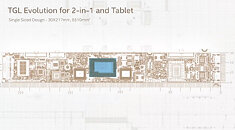


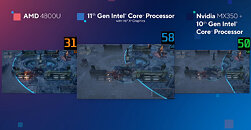





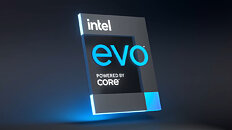



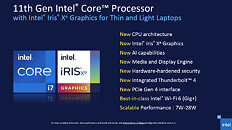
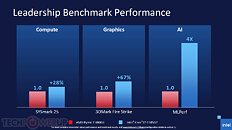
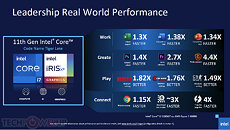
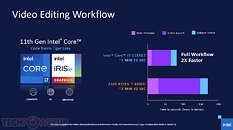
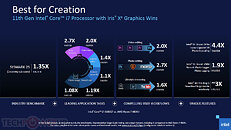
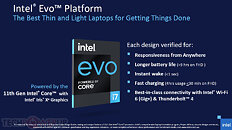




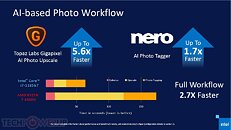
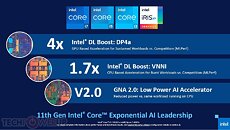
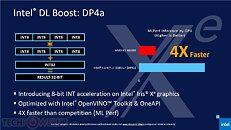
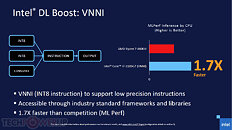
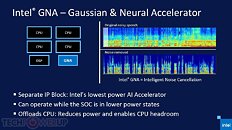
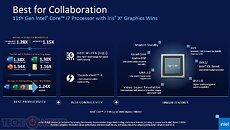
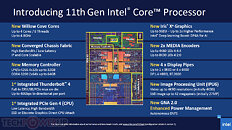
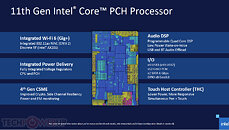
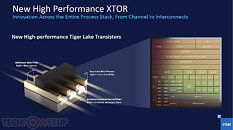



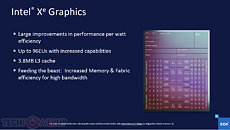

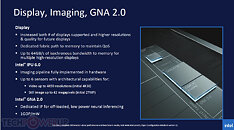
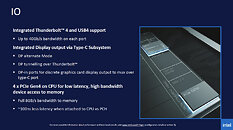
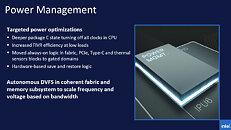
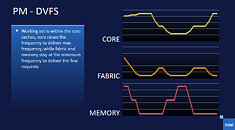
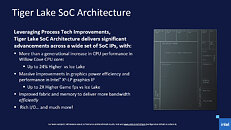

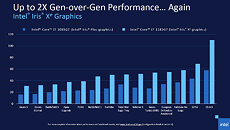

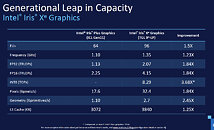

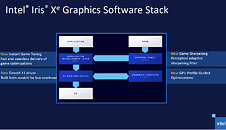


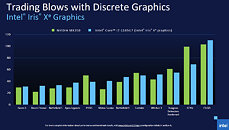
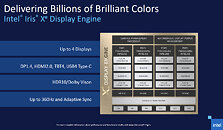


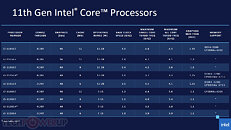
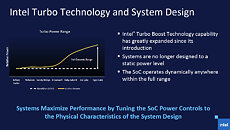
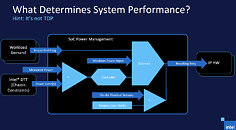
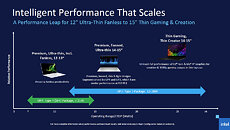
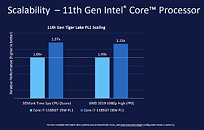

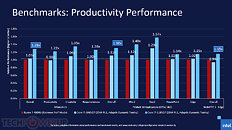
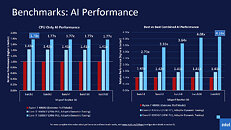
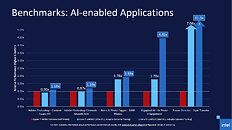
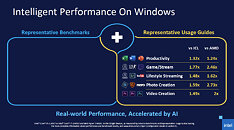
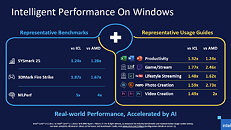
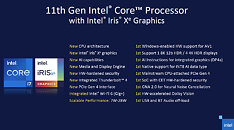




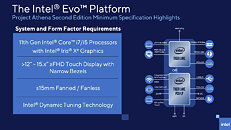
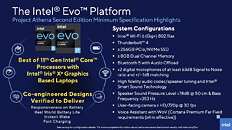








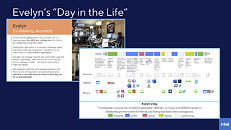









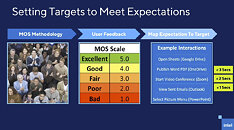

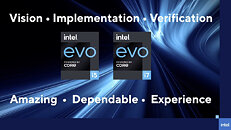



69 Comments on Intel 11th Gen Core "Tiger Lake" & Xe Graphics Launch Event: Live Blog
The dual-channel LPDDR4 is within spec for the Intel system and the dual-channel DDR4 also within spec for the AMD system. Are you about to tell me that Ice Lake running LPDDR4-3733 is also an unfair advantage for Intel?
It seens to me they are not comparing CPU's, but actually Intel's new CPU against some lenovo that happens to use AMD Ryzen mobile CPU in it.
Firmware-wise, we don't know. Lenovo does some strange things with power limits on Intel laptops by handicapping them to strictly their TDP. With Renoir, AMD has given OEMs a lot of flexibility when it comes to the performance parameters that they can choose.
But, about creating special enhanced system, to be clear, I'm not saying they did, but it would not be the first time. Not so long ago, they presented a Xeon 28 core CPU live demonstration, runing a very, and I mean very special cooling unit to maintain a very high level of overclock, that they never mentioned when presenting it, only days later after people saw a weird photo of a pipe just chilling away from the system.
If it was apples to apples, then show us the full spec of memory, they have a dedicated page to all systems they used, why not put memory specs also?
edc.intel.com/content/www/us/en/products/performance/benchmarks/11th-generation-intel-core-mobile-processors/
www.amd.com/en/products/apu/amd-ryzen-7-4800u
So, a 28W 4C8T 4267Mhz RAM vs a 15W 8C16T with 3200Mhz RAM.
Congrats on shitty comparison Intel, so in all reality Xe is about 25% slower than AMD APU hardware.
Renoir also purportedly supports LPDDR4-4266; the problem is that most Renoir chips end up in thicker laptops with SO-DIMM slots, so no OEMs bother to put in the work to design a LPDDR4-based Renoir laptop because the other 10 SKUs all use soldered or socketed DDR4. You can't test what doesn't exist.
And even had there been a LPDDR4 Renoir ultrabook, I highly doubt the Vega iGPU would see any gains compared to dual-channel DDR4-3200. Same goes for Tiger Lake, there's no reason why LPDDR4-4266 makes it magically faster. LPDDR4 is for power efficiency, not performance. Renoir already achieves fantastic battery life improvements with DDR4.
IIRC, LPDDR4 literally has half the bus width of DDR4.
The point of concern you're looking for here is the continued use of high turbo frequencies that draw power way beyond TDP and PL2. PL1 and PL2 are in the hands of laptop manufacturers, and there's often nothing that can be done if the OEM decides to set PL2 at strictly TDP, which absolutely hobbles your long-term turbo performance. That's something we'll only know from laptop reviewers once the products hit the market.
50W at boost vesus a cpu that maxes out at 25W....hmmmm back to it's old pr tricks
And I wouldn't be surprised in the least bit if OEMs were paid to avoid putting this LPDDR4x on top end Ryzen, especially given it's relatively cheap being the bog standard on all mobiles these days & ICL only supporting up to 3733 MHz!
www.tomshardware.com/news/lenovo-yoga-slim-7-review-tested
Lenovo Yoga Slim 7 Specifications
I still stand by my opinion that this SuperFin is not as great as they claimed to be. I feel is just allow the existing 10nm to take in more power (on top of some efficiency gain), and thus, allow a higher clockspeed. Basically they are just pushing 10nm to be like 14nm to run at higher clockspeed. At least it is good to see healthy IPC improvement from Intel, and not another improvement to clockspeed only. Power requirement increase will show in battery tests.I don't know if it is a driver problem though.
Is it gameover ?
alright maybe i read more thoroughly ... i have a bit of time to waste and a good laugh will not hurt ...
Nice try. Intel manages to make every single chart they show worthless and deceiving without fault. That's quite the feat, I know every company tries to do same but no has been as consistent as Intel. Whenever you see one their benchmarks might as well look at brick wall instead, you're going to find out just as much.